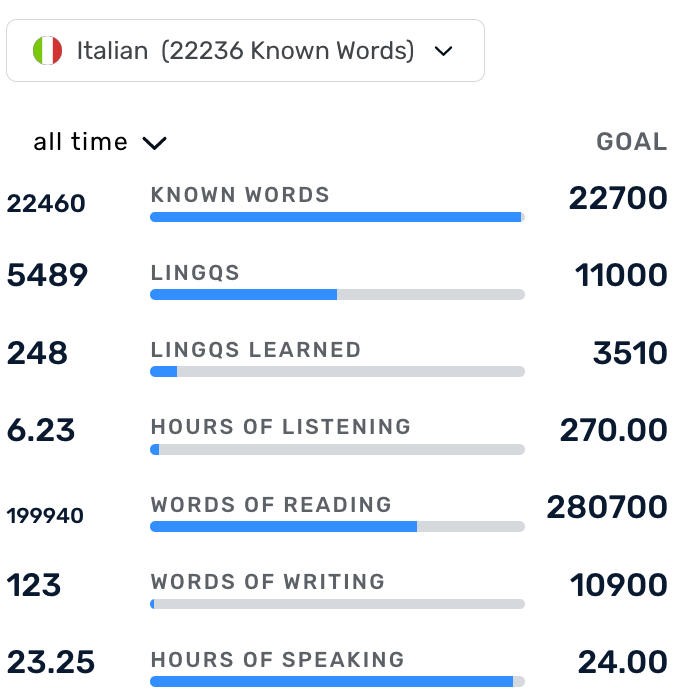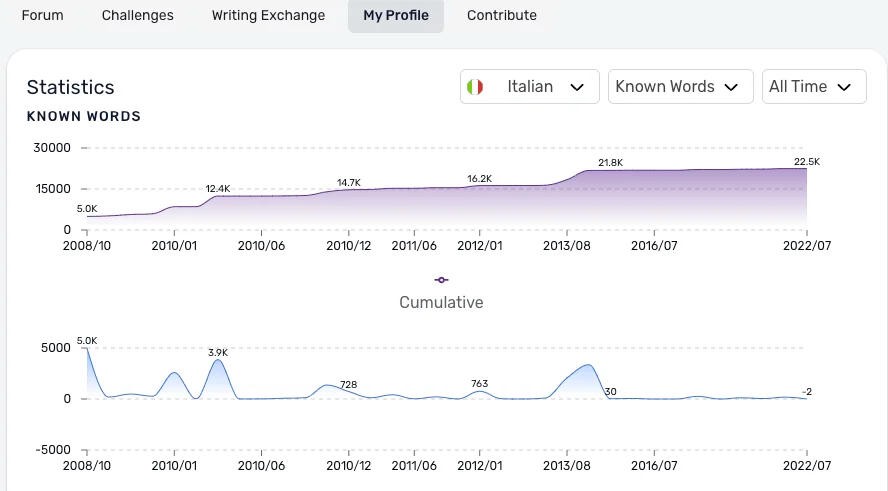Learning the Italian language quickly is achievable with the right strategies and resources. This guide, brought to you by LEARNS.EDU.VN, provides effective methods to accelerate your Italian learning journey, focusing on practical techniques and readily available tools. Discover how to efficiently acquire vocabulary, master grammar, and immerse yourself in the Italian language, paving the way for fluency. Embark on this linguistic adventure and unlock the beauty of the Italian language with immersive techniques, grammar essentials, and language learning platforms.
1. Define Your Italian Learning Goals
Before diving into textbooks and language apps, take a moment to clearly define your Italian language learning goals. Understanding why you want to learn Italian will provide the motivation and direction you need to stay on track.
1.1. Identify Specific Objectives
Are you planning a trip to Italy? Do you want to read Italian literature? Or perhaps you have Italian-speaking family members you’d like to communicate with? Whatever your reason, identifying specific objectives will help you tailor your learning approach.
- Travel: Focus on conversational Italian, including common phrases, ordering food, and asking for directions.
- Literature: Prioritize vocabulary related to literature, history, and culture.
- Family: Learn everyday expressions, family-related vocabulary, and cultural nuances.
1.2. Set Realistic Timelines
Rome wasn’t built in a day, and neither is fluency in Italian. Set realistic timelines for achieving your goals. Break down your learning journey into smaller, manageable milestones.
| Milestone | Timeline | Activities |
|---|---|---|
| Basic Conversation | 3 Months | Learn greetings, basic phrases, and common vocabulary. |
| Intermediate Fluency | 6 Months | Engage in more complex conversations, read simple texts, and write emails. |
| Advanced Proficiency | 12 Months | Read novels, watch Italian films, and participate in advanced discussions. |




1.3. Stay Motivated
Learning a new language can be challenging, so it’s important to stay motivated. Celebrate your progress, reward yourself for achieving milestones, and find ways to make learning fun.
- Join a Language Exchange: Practice speaking with native Italian speakers.
- Watch Italian Movies: Immerse yourself in the language and culture.
- Listen to Italian Music: Familiarize yourself with the sounds and rhythms of the language.
2. Embrace Immersion Techniques
Immersion is one of the most effective ways to learn Italian quickly. By surrounding yourself with the language, you’ll naturally absorb vocabulary, grammar, and pronunciation.
2.1. Create an Italian Environment
Transform your living space into an Italian oasis. Label household items with their Italian names, listen to Italian music while you work, and watch Italian news programs.
- Labeling: Use sticky notes to label furniture, appliances, and other items with their Italian names.
- Music: Create an Italian playlist with a variety of genres, from classical to pop.
- News: Watch Italian news channels online or through streaming services.
2.2. Travel to Italy (or Virtually Explore)
If possible, plan a trip to Italy to immerse yourself in the language and culture. If a physical trip isn’t feasible, explore Italy virtually through online tours, documentaries, and language exchange partners.
- Language Schools: Consider enrolling in an intensive Italian language course in Italy.
- Virtual Tours: Take virtual tours of Italian cities, museums, and historical sites.
- Language Exchange: Connect with native Italian speakers online for language exchange sessions.
2.3. Engage with Italian Media
Immerse yourself in Italian media, such as movies, TV shows, podcasts, and books. Start with content that is appropriate for your current level and gradually increase the difficulty.
- Movies: Watch Italian films with subtitles, gradually reducing your reliance on them.
- TV Shows: Stream Italian TV shows on platforms like Netflix or RaiPlay.
- Podcasts: Listen to Italian podcasts on topics that interest you.
- Books: Start with children’s books or graded readers and gradually move on to more complex literature.
3. Master Italian Grammar Fundamentals
While immersion is crucial, a solid understanding of Italian grammar is essential for building a strong foundation in the language.
3.1. Focus on Core Grammar Concepts
Start by mastering the core grammar concepts, such as verb conjugations, noun genders, and sentence structure. Don’t try to learn everything at once; focus on one concept at a time and practice it until you’re comfortable.
- Verb Conjugations: Learn the most common verb conjugations, such as essere (to be), avere (to have), and fare (to do).
- Noun Genders: Understand that Italian nouns are either masculine or feminine, and this affects the articles and adjectives used with them.
- Sentence Structure: Learn the basic word order in Italian sentences, which is typically subject-verb-object.
3.2. Use Grammar Resources
Utilize grammar resources such as textbooks, workbooks, and online grammar guides. Supplement your learning with grammar exercises and quizzes to reinforce your understanding.
- Essential Italian Grammar by Olga Ragusa: A comprehensive grammar book that covers all the essential concepts.
- Online Grammar Guides: Websites like Babbel and Duolingo offer interactive grammar lessons and exercises.
- Workbooks: Practice grammar exercises in workbooks to solidify your knowledge.
3.3. Practice with Real-Life Examples
Apply your grammar knowledge by practicing with real-life examples. Write sentences, engage in conversations, and analyze Italian texts to see how grammar rules are used in context.
- Write Sentences: Practice writing sentences using different grammar structures.
- Engage in Conversations: Use your grammar knowledge in conversations with native speakers.
- Analyze Italian Texts: Identify grammar rules in Italian texts and understand how they are applied.
4. Build Your Italian Vocabulary
A rich vocabulary is essential for understanding and expressing yourself in Italian. Focus on learning high-frequency words and phrases that are relevant to your interests and goals.
4.1. Learn High-Frequency Words
Start by learning the most common Italian words, which will enable you to understand a large percentage of everyday conversations and texts.
| Word | Translation | Example Sentence |
|---|---|---|
| Essere | To be | Io sono uno studente. (I am a student.) |
| Avere | To have | Lei ha un libro. (She has a book.) |
| Fare | To do | Noi facciamo i compiti. (We do the homework.) |
| Andare | To go | Voi andate al cinema. (You go to the cinema.) |
| Parlare | To speak | Loro parlano italiano. (They speak Italian.) |
4.2. Use Flashcards and Spaced Repetition
Use flashcards and spaced repetition systems (SRS) to memorize new vocabulary. These techniques help you review words at increasing intervals, which improves long-term retention.
- Physical Flashcards: Create flashcards with the Italian word on one side and the English translation on the other.
- Digital Flashcards: Use apps like Anki or Memrise to create and review digital flashcards.
- Spaced Repetition Systems: SRS algorithms optimize the review schedule for maximum retention.
4.3. Learn Words in Context
Instead of memorizing words in isolation, learn them in context by reading Italian texts, watching Italian videos, and listening to Italian conversations. This will help you understand how words are used in different situations.
- Read Italian Texts: Look up unfamiliar words in a dictionary and note how they are used in the sentence.
- Watch Italian Videos: Pay attention to how words are pronounced and used in conversations.
- Listen to Italian Conversations: Try to understand the meaning of unfamiliar words from the context.
5. Practice Speaking Italian Regularly
Speaking Italian regularly is essential for developing fluency and confidence. Don’t be afraid to make mistakes; the more you practice, the better you’ll become.
5.1. Find a Language Partner or Tutor
Find a language partner or tutor who can provide you with feedback and guidance. Language exchange partners are native Italian speakers who want to learn your language, while tutors are professional teachers who can provide structured lessons.
- Language Exchange Websites: Websites like Tandem and HelloTalk connect language learners from around the world.
- Online Tutors: Platforms like iTalki and Verbling offer lessons with certified Italian teachers.
- Local Language Groups: Join local language groups or conversation clubs to practice speaking Italian with other learners.
5.2. Engage in Conversational Practice
Engage in conversational practice as often as possible. Talk to yourself in Italian, record yourself speaking, and participate in online language exchange sessions.
- Talk to Yourself: Describe your daily activities, express your opinions, and practice grammar structures.
- Record Yourself Speaking: Listen to your recordings and identify areas for improvement.
- Online Language Exchange Sessions: Use video conferencing tools like Skype or Zoom to practice speaking with native speakers.
5.3. Participate in Language Challenges
Participate in language challenges to push yourself and stay motivated. Challenges can range from speaking for a certain number of minutes each day to writing a short story in Italian.
- 30-Day Speaking Challenge: Commit to speaking Italian for at least 30 minutes each day for 30 days.
- Weekly Writing Challenge: Write a short paragraph or essay in Italian each week.
- Language Learning Competitions: Participate in online language learning competitions and challenges.
6. Utilize Language Learning Apps and Tools
Language learning apps and tools can supplement your learning and make it more engaging. Choose apps and tools that align with your learning style and goals.
6.1. Explore Popular Language Learning Apps
Explore popular language learning apps such as Duolingo, Babbel, and Memrise. These apps offer interactive lessons, vocabulary exercises, and grammar explanations.
| App | Features | Price |
|---|---|---|
| Duolingo | Gamified lessons, vocabulary practice, grammar explanations, personalized learning paths | Free (with ads), Premium available |
| Babbel | Structured courses, real-life conversations, grammar tips, pronunciation practice | Subscription-based |
| Memrise | Flashcards, spaced repetition, user-generated content, video and audio clips | Free (with ads), Premium available |
6.2. Use Online Dictionaries and Translation Tools
Use online dictionaries and translation tools to look up unfamiliar words and phrases. However, be careful not to rely too heavily on translation tools, as they can sometimes provide inaccurate translations.
- WordReference: A popular online dictionary with accurate translations and example sentences.
- Google Translate: A widely used translation tool that can translate text and web pages.
- Linguee: A dictionary that provides contextual examples of words and phrases in both English and Italian.
6.3. Leverage Language Learning Platforms
Leverage language learning platforms such as LingQ to access a vast library of Italian content. These platforms allow you to read, listen, and learn from authentic materials.
- LingQ: A language learning platform that offers a vast library of Italian content, including articles, podcasts, and videos.
- italki: A platform that connects language learners with native Italian teachers for online lessons.
- Babbel: Another platform that offers structured Italian courses and interactive lessons.
7. Immerse Yourself in Italian Culture
Learning a language is about more than just vocabulary and grammar; it’s also about understanding the culture. Immerse yourself in Italian culture to gain a deeper appreciation for the language and its speakers.
7.1. Explore Italian Cuisine
Explore Italian cuisine by cooking Italian dishes, trying Italian restaurants, and learning about Italian culinary traditions.
- Cook Italian Dishes: Find Italian recipes online or in cookbooks and try making them at home.
- Visit Italian Restaurants: Order Italian dishes at local restaurants and learn about the ingredients and preparation methods.
- Learn About Italian Culinary Traditions: Read about the history and culture of Italian cuisine.
7.2. Learn About Italian History and Art
Learn about Italian history and art by visiting museums, reading books, and watching documentaries.
- Visit Museums: Visit museums in Italy or your local area that feature Italian art and historical artifacts.
- Read Books: Read books about Italian history, art, and culture.
- Watch Documentaries: Watch documentaries about Italian history and art on platforms like Netflix or YouTube.
7.3. Connect with Italian Communities
Connect with Italian communities in your local area or online. Attend Italian festivals, join Italian clubs, and participate in online forums and social media groups.
- Attend Italian Festivals: Look for Italian festivals in your local area and attend them to experience Italian culture firsthand.
- Join Italian Clubs: Join Italian clubs or organizations to connect with other Italian speakers and learners.
- Participate in Online Forums and Social Media Groups: Join online forums and social media groups dedicated to Italian language and culture.
8. Stay Consistent and Patient
Learning Italian quickly requires consistency and patience. Don’t get discouraged if you don’t see results immediately; keep practicing and you’ll eventually reach your goals.
8.1. Establish a Regular Study Routine
Establish a regular study routine and stick to it as much as possible. Set aside a specific time each day or week to study Italian.
- Daily Study Schedule: Dedicate 30-60 minutes each day to studying Italian.
- Weekly Study Plan: Create a weekly study plan that includes specific activities, such as grammar exercises, vocabulary review, and conversational practice.
- Track Your Progress: Keep track of your progress and celebrate your achievements.
8.2. Be Patient and Persistent
Be patient and persistent, and don’t give up if you encounter challenges. Learning a new language takes time and effort, so be prepared to invest both.
- Set Realistic Expectations: Understand that fluency takes time and effort, and don’t expect to become fluent overnight.
- Celebrate Small Victories: Acknowledge and celebrate your progress, no matter how small.
- Don’t Be Afraid to Make Mistakes: Mistakes are a natural part of the learning process, so don’t be afraid to make them.
8.3. Seek Support and Encouragement
Seek support and encouragement from friends, family, or other language learners. Having a support network can help you stay motivated and overcome challenges.
- Join a Language Learning Community: Connect with other language learners online or in your local area.
- Share Your Progress with Others: Share your progress with friends and family and ask for their support.
- Seek Feedback and Advice: Ask for feedback and advice from experienced language learners or teachers.
9. Tailor Your Learning to Your Style
Everyone learns differently, so it’s important to tailor your learning approach to your individual style.
9.1. Identify Your Learning Preferences
Determine whether you’re a visual, auditory, or kinesthetic learner and adjust your learning methods accordingly.
- Visual Learners: Benefit from using flashcards, watching videos, and reading texts.
- Auditory Learners: Learn best by listening to podcasts, music, and conversations.
- Kinesthetic Learners: Prefer hands-on activities, such as role-playing and interactive exercises.
9.2. Adapt Methods to Suit Your Needs
Adapt your learning methods to suit your specific needs and preferences. Experiment with different techniques and resources to find what works best for you.
- Personalized Learning: Create a personalized learning plan that takes into account your goals, interests, and learning style.
- Flexible Study Schedule: Adjust your study schedule to fit your lifestyle and commitments.
- Diverse Resources: Use a variety of resources, such as textbooks, apps, websites, and native speakers, to diversify your learning experience.
9.3. Embrace a Growth Mindset
Cultivate a growth mindset, believing that your abilities can be developed through dedication and hard work.
- Believe in Your Potential: Have confidence in your ability to learn Italian.
- View Challenges as Opportunities: Embrace challenges as opportunities for growth and learning.
- Persistence and Resilience: Stay persistent and resilient in the face of setbacks.
10. Leverage Free Italian Learning Resources
Learning Italian doesn’t have to break the bank. Numerous free resources are available to help you on your journey.
10.1. Free Online Courses
Take advantage of free online courses offered by universities and language learning platforms.
- Coursera: Offers a variety of Italian language courses from top universities.
- edX: Provides access to Italian language courses taught by experienced instructors.
- Duolingo: Offers a free, gamified approach to learning Italian.
10.2. Free Language Exchange Platforms
Connect with native Italian speakers through free language exchange platforms.
- Tandem: A mobile app that connects language learners for language exchange.
- HelloTalk: A language learning app that allows you to chat with native speakers.
- ConversationExchange: A website that connects language partners for online conversations.
10.3. Free Italian Learning Websites and Apps
Utilize free Italian learning websites and apps to supplement your learning.
- ItalianPod101: Offers free audio and video lessons for learning Italian.
- Memrise: Provides free access to user-generated Italian language courses.
- Learn Italian with Coffee Break Italian: A free podcast that teaches you Italian in short, manageable lessons.
Remember that LEARNS.EDU.VN offers a wide array of resources and courses designed to help you learn Italian efficiently. Visit our website at learns.edu.vn to explore our offerings and find the perfect resources to support your learning journey. Contact us at 123 Education Way, Learnville, CA 90210, United States or Whatsapp: +1 555-555-1212 for more information.
FAQ: Learn Italian Language Quickly
Q1: How long does it take to learn Italian fluently?
The time it takes to learn Italian fluently varies depending on your learning style, dedication, and available resources. On average, it takes approximately 600-750 hours of study to achieve conversational fluency in Italian.
Q2: What is the best way to start learning Italian?
Start by mastering the basics of Italian grammar and vocabulary. Focus on learning high-frequency words and phrases, and practice speaking and listening regularly.
Q3: Can I learn Italian on my own?
Yes, it is possible to learn Italian on your own by using online resources, language learning apps, and textbooks. However, it can be helpful to supplement your self-study with lessons from a tutor or language partner.
Q4: Which is easier to learn, Spanish or Italian?
Both Spanish and Italian are Romance languages and share many similarities. However, most learners find Spanish slightly easier due to its simpler pronunciation and grammar rules.
Q5: What are some common mistakes that Italian learners make?
Common mistakes include incorrect verb conjugations, misuse of noun genders, and improper word order. Pay attention to these areas and practice regularly to avoid making these mistakes.
Q6: How can I improve my Italian pronunciation?
Improve your pronunciation by listening to native Italian speakers and practicing speaking regularly. Pay attention to the sounds of the language and try to mimic them as closely as possible.
Q7: What are some useful resources for learning Italian vocabulary?
Useful resources include flashcards, spaced repetition systems, and online dictionaries. Learn words in context by reading Italian texts and watching Italian videos.
Q8: How can I make learning Italian more fun?
Make learning Italian more fun by incorporating activities that you enjoy, such as watching Italian movies, listening to Italian music, and cooking Italian dishes.
Q9: What is the best way to stay motivated while learning Italian?
Stay motivated by setting realistic goals, celebrating your progress, and finding ways to make learning fun. Connect with other language learners and seek support and encouragement.
Q10: How important is it to learn about Italian culture when learning the language?
Learning about Italian culture is essential for gaining a deeper appreciation for the language and its speakers. Immerse yourself in Italian culture by exploring Italian cuisine, history, and art.

